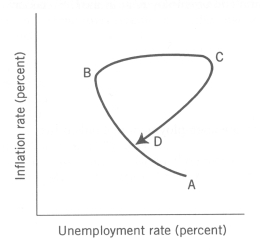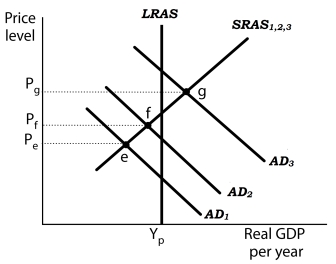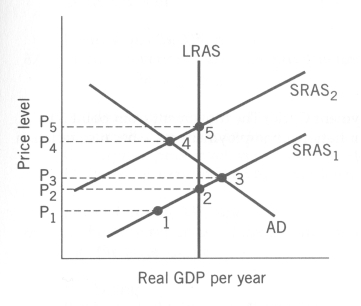A) 7%
B) 4%
C) 1%
D) -1%
F) B) and D)
Correct Answer

verified
Correct Answer
verified
True/False
The efficiency-wage theory holds that self-correction in an economy will not automatically eliminate a recessionary gap.
B) False
Correct Answer

verified
Correct Answer
verified
Multiple Choice
What are three phases of inflation-unemployment cycles?
A) An expansionary phase, a full-employment phase, and a contractionary phase
B) A Phillips phase, a stagflation phase, and a growth phase
C) A Phillips phase, a stagflation phase, and a recovery phase
D) An expansionary phase, a stagflation phase, and a recovery phase
F) A) and D)
Correct Answer

verified
Correct Answer
verified
True/False
For a given labor force, an increase in real GDP implies a decrease in unemployment.
B) False
Correct Answer

verified
Correct Answer
verified
Multiple Choice
The theory that holds that firms may try to increase productivity by paying a wage in excess of the market-clearing wage is called the
A) efficiency-wage theory.
B) reservation wage theory.
C) excess wage theory.
D) wage-inflation theory.
F) A) and C)
Correct Answer

verified
Correct Answer
verified
Multiple Choice
Efficiency wages cause unemployment because
A) firms pay wages that are below the market wage, causing the quantity of labor demanded to be greater than the quantity of labor supplied.
B) firms pay wages that are below the market wage, causing the quantity of labor demanded to be less than the quantity of labor supplied.
C) firms pay wages that are above the market wage, causing the quantity of labor demanded to be greater than the quantity of labor supplied.
D) firms pay wages that are above the market wage, causing the quantity of labor demanded to be less than the quantity of labor supplied.
F) A) and C)
Correct Answer

verified
Correct Answer
verified
Multiple Choice
Use the following to answer questions .
Exhibit: Inflation and Unemployment 2  -(Exhibit: Inflation and Unemployment 2) The figure shows the three inflation-unemployment
Phases. What are these three phases, moving clockwise from point A?
-(Exhibit: Inflation and Unemployment 2) The figure shows the three inflation-unemployment
Phases. What are these three phases, moving clockwise from point A?
A) Phillips phase, recovery phase, stagflation phase
B) Recovery phase, stagflation phase, Phillips phase
C) Phillips phase, stagflation phase, recovery phase
D) Stagflation phase, recovery phase, Phillips phase
F) None of the above
Correct Answer

verified
Correct Answer
verified
Multiple Choice
Use the following to answer questions .
Exhibit: Aggregate Demand Shifts and Expectations  -(Exhibit: Aggregate Demand Shifts and Expectations) Suppose the economy was operating at point e in period 1. Expansionary fiscal and monetary policies adopted in period 1 resulted in a movement to point g in period 3. When workers and firms adjust their expectations in a higher price level and act on these expectations, the economy moves from a
-(Exhibit: Aggregate Demand Shifts and Expectations) Suppose the economy was operating at point e in period 1. Expansionary fiscal and monetary policies adopted in period 1 resulted in a movement to point g in period 3. When workers and firms adjust their expectations in a higher price level and act on these expectations, the economy moves from a
A) expansionary phase to a recovery phase.
B) Phillips phase to a stagflation phase.
C) Phillips phase to a recovery phase.
D) stagflation phase to a recovery phase.
F) None of the above
Correct Answer

verified
Correct Answer
verified
Multiple Choice
Prior to the 1970s, the model of choice was the aggregate expenditures model. According to This model, if the economy was in equilibrium at an income greater than the full employment level, then the primary economic problem would be
A) excessive bank lending.
B) potential crises in financial markets.
C) inflation.
D) excess aggregate demand.
F) B) and C)
Correct Answer

verified
Correct Answer
verified
Multiple Choice
Use the following to answer questions .
Exhibit: AD-AS and the Inflation-Unemployment Cycle  -(Exhibit: AD-AS and the Inflation-Unemployment Cycle) Suppose initially the economy was at point 1 and as a result of
Stabilization policies, it is now at point 3. Consequently, there will be pressure for
-(Exhibit: AD-AS and the Inflation-Unemployment Cycle) Suppose initially the economy was at point 1 and as a result of
Stabilization policies, it is now at point 3. Consequently, there will be pressure for
A) workers to settle for lower nominal wages.
B) firms to decrease prices.
C) workers and firms to incorporate price increases into their expectations.
D) the Fed to buy bonds in the open market.
F) C) and D)
Correct Answer

verified
Correct Answer
verified
Multiple Choice
Which of the following statements is true of the U.S. experience with regards to the Phillips curve hypothesis? I. Annual observations of inflation and unemployment from 1961 to 2015 seem consistent with a Phillips curve. II. A Phillips curve relationship best fits observations of inflation and unemployment in the 1960s. III. The Phillips curve relationship in the inflation and unemployment data began to disintegrate in the 1970s.
A) I only
B) II only
C) III only
D) II and III only
F) A) and D)
Correct Answer

verified
Correct Answer
verified
Multiple Choice
Use the following to answer questions .
Exhibit: Inflation and Unemployment 2  -(Exhibit: Inflation and Unemployment 2) Which of the following movements represents a Phillips phase?
-(Exhibit: Inflation and Unemployment 2) Which of the following movements represents a Phillips phase?
A) The movement from A to B
B) The movement from B to C
C) The movement from C to D
D) The movement from B to A
F) All of the above
Correct Answer

verified
Correct Answer
verified
True/False
In a Phillips phase, the short-run aggregate supply curve shifts to the right.
B) False
Correct Answer

verified
Correct Answer
verified
True/False
If workers and firms adjust their expectations of future prices in a higher price level, the short-run aggregate supply curve shifts to the right.
B) False
Correct Answer

verified
Correct Answer
verified
True/False
Sustained inflation over many years is most likely due to increases in the money supply in excess of increases in potential output.
B) False
Correct Answer

verified
Correct Answer
verified
Multiple Choice
Consider the following statement: "President X expressed concern about reports of rising inflation but insisted the economy is on the right course. He pointed to recent reductions in unemployment as evidence that his economic policies are working." Identify the stage of the inflation-unemployment relationship.
A) The stagflation phase
B) The recovery phase
C) The Phillips phase
D) The contraction phase
F) A) and C)
Correct Answer

verified
Correct Answer
verified
Multiple Choice
Use the following to answer questions .
Exhibit: Shifts in Aggregate Demand and Aggregate Supply and Inflation-Unemployment Phases  -(Exhibit: Shifts in Aggregate Demand and Aggregate Supply and Inflation-Unemployment Phases) The movement from point 4 to point 5 is consistent with which inflation-unemployment phase?
-(Exhibit: Shifts in Aggregate Demand and Aggregate Supply and Inflation-Unemployment Phases) The movement from point 4 to point 5 is consistent with which inflation-unemployment phase?
A) Phillips phase because inflation is increasing while unemployment is falling
B) recovery phase because although inflation has risen, unemployment has fallen
C) growth phase because the economy is producing above its potential output
D) recovery phase because inflation and unemployment have fallen
F) B) and D)
Correct Answer

verified
Correct Answer
verified
Multiple Choice
The Phillips phase of the inflation-unemployment relationship drives the price level
A) below what workers and firms expected causing nominal wages to fall below their expected level.
B) below what workers and firms expected causing real wages to rise above their expected level.
C) above what workers and firms expected causing nominal wages to rise above their expected level.
D) above what workers and firms expected causing real wages to fall below their expected level.
F) C) and D)
Correct Answer

verified
Correct Answer
verified
Multiple Choice
The efficiency-wage theory predicts that
A) profit-maximizing firms will maintain the wage level at a rate too low to achieve full employment in the labor market.
B) wage rigidities will be eliminated even in the short-run.
C) firms will maintain the wage level at a rate too high to achieve full employment in the labor market.
D) the labor market clears at a wage rate above equilibrium.
F) B) and C)
Correct Answer

verified
Correct Answer
verified
Multiple Choice
Use the following to answer questions .
Exhibit: Shifts in Aggregate Demand and Aggregate Supply and Inflation-Unemployment Phases  -(Exhibit: Shifts in Aggregate Demand and Aggregate Supply and Inflation-Unemployment Phases) The movement from point 3 to point 4 is consistent with which
Segment in the diagram below?
-(Exhibit: Shifts in Aggregate Demand and Aggregate Supply and Inflation-Unemployment Phases) The movement from point 3 to point 4 is consistent with which
Segment in the diagram below? 
A) Segment A to D
B) Segment A to B
C) Segment B to C
D) Segment C to D
F) B) and D)
Correct Answer

verified
Correct Answer
verified
Showing 81 - 100 of 132
Related Exams